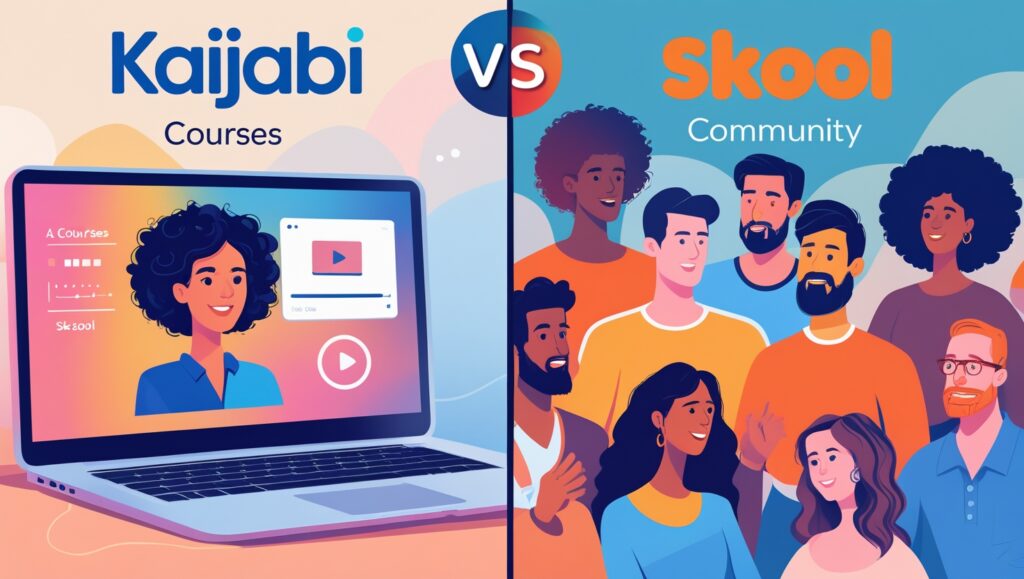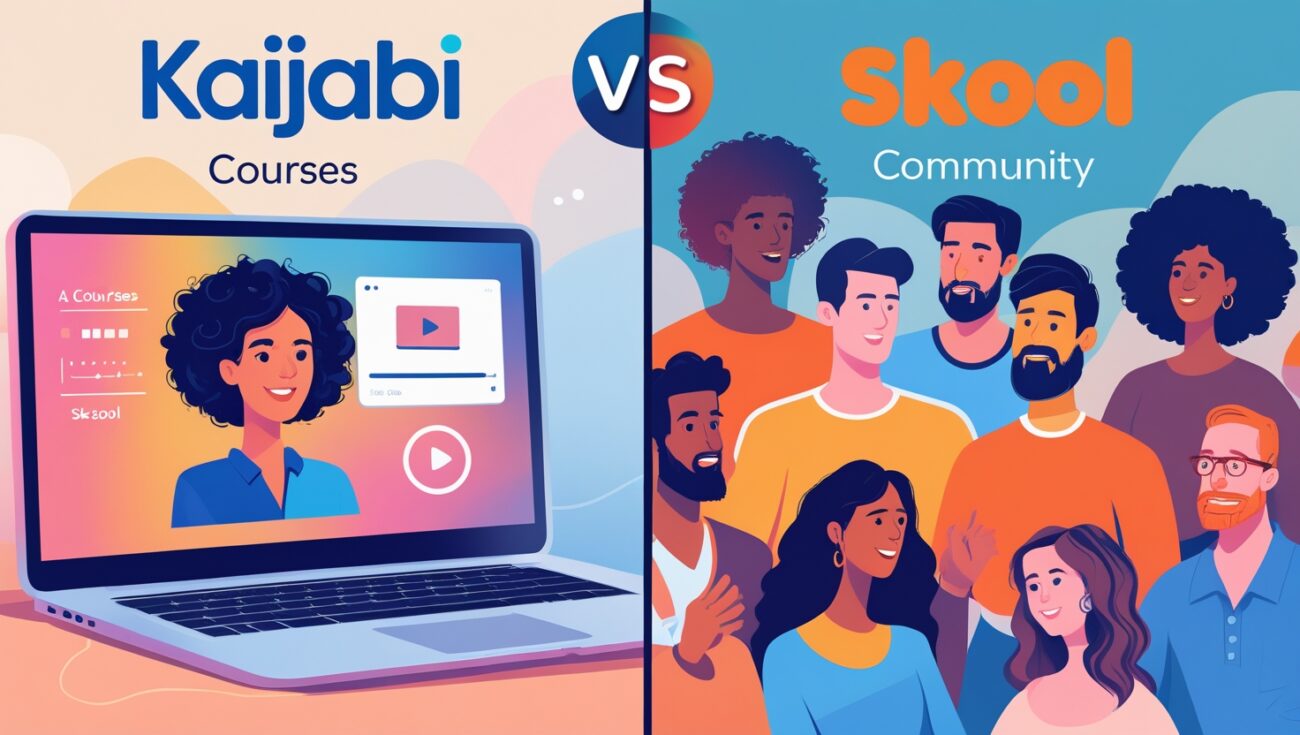Kajabi vs Skool: Which Is Better for Courses and Community?
As someone who’s built online courses and paid communities for years, I’ve tried just about every platform — and Kajabi and Skool are two of the most talked about in 2025. I used both, side by side, to figure out which one actually delivers better value, ease of use, and long-term results.
If you’re stuck choosing between Kajabi and Skool, I’m going to break it down from my real-world experience. This isn’t theory. I’ve built on both — and I’m here to help you avoid wasting time and money.

Table of Contents
Ease of Use: Skool Wins for Simplicity
Kajabi has a lot of features — and that’s not always a good thing. When I first started using it, I felt overwhelmed. It took me days just to set up a basic funnel and upload my course. There were so many buttons and options, it started to feel like I needed a degree to run it.
Skool, on the other hand, was refreshingly simple. I set up my entire community, course, and payment system in one afternoon. No tech headaches. No Zapier. No tutorials. It just worked. If you’re looking to get started fast and stay focused, Skool is the clear winner.
Community Features: Skool Built for Engagement
Let me be real — Kajabi’s “community” feature felt like an afterthought. It’s clunky and barely anyone used it. My students would message me saying they forgot it even existed.
Skool’s community is the opposite. It’s built to keep people active. The feed, gamification, and calendar make engagement part of the platform, not an extra add-on. My group members come back daily. They post. They comment. They help each other. That kind of interaction is priceless — and I didn’t have it on Kajabi.
Course Delivery: Both Are Solid, But Skool Keeps It Cleaner
Kajabi gives you a lot of tools to design and customize your course area. But too much customization can slow you down. I spent hours picking fonts, colors, thumbnails — when I should have been creating more content or serving clients.
Skool keeps things clean. The Classroom tab is simple, organized, and distraction-free. My members can jump straight into the content without getting lost in a maze of design elements.
Payments and Setup: Skool Is Faster
With Kajabi, I had to go through several steps to connect Stripe, set up checkout pages, build offers, and create email automations. It’s powerful, but not fast.
Skool? I connected my Stripe account, set a price, and was collecting payments the same day. The platform handles access control, member management, and renewals automatically. No extra tools. No third-party services. No stress.
Pricing: Kajabi Costs More — A Lot More
In 2025, Kajabi starts at $149/month and goes up fast if you want more contacts, products, or admin seats. Once I added email marketing and automation, I was paying nearly $200/month.
Skool? Flat $99/month — unlimited members, unlimited courses, unlimited events. That’s it. No hidden upgrades. No upsells. For most creators, Skool does everything they need — and for less.
Try Skool for $99/month here with my affiliate link
Support and Community: Skool’s Team Actually Listens
Kajabi has decent support, but it always felt corporate to me. With Skool, the support team actually responds in the community, fixes bugs fast, and rolls out updates that users actually asked for.
I’ve seen features go from idea to implementation in weeks — not months. That kind of responsiveness is rare, and it shows that Skool is still creator-focused.
Do You Need Funnels and Email Marketing?
If you’re building a complex funnel with upsells, downsells, and long email sequences, Kajabi might give you more flexibility. But in my experience, most creators don’t need that much complexity.
I sell my memberships and courses directly inside Skool, using my content and community to do the heavy lifting. No complicated funnels needed. For me, that made the business easier and more profitable.
My Final Verdict: Skool Is Better for 90% of Creators
If you’re a coach, course creator, or expert looking to build a high-value, engaged community, Skool is where I’d start. It’s faster to launch, easier to run, and better for building real relationships with your members.
Kajabi still works — but only if you need advanced marketing features. For everyone else? Skool is the simpler, smarter choice.
Click here to launch your community with Skool
One of the biggest problems I had with Kajabi was how overwhelming it felt. I spent so much time setting things up — but not enough time connecting with my students. Skool helped me flip that. I now spend more time delivering value, not fighting tech.
In my early Kajabi days, I needed extra tools like ConvertKit or Zapier to fill the gaps. I couldn’t believe how fast those extra costs added up. With Skool, I cut out almost every tool I used to rely on — which not only saved me money but also reduced stress.
I also noticed that Skool made my members feel more “at home.” The layout is intuitive, the notifications are clear, and the experience feels social — not sterile like some other platforms. That increased member retention without me having to lift a finger.
When you build a business, you want momentum. Skool gave me that. In just a few clicks, I was live and selling. Kajabi often made me feel like I needed a full-time assistant just to keep everything organized.
Another major issue I had with Kajabi was the constant need to update things. From emails to automations to page layouts, I was always tweaking. With Skool, the platform’s minimalism works in my favor. I don’t feel the pressure to over-optimize.
I also appreciated how Skool doesn’t force me to be a marketer. I get to focus on my content and community, which is where my real impact happens. Kajabi felt like a tool for people who wanted to run giant launches. I wanted something more consistent and grounded.
The Skool leaderboard and gamification tools actually encourage my members to participate. I’ve seen people go from silent lurkers to active contributors just because they wanted to move up in the group. That’s something Kajabi couldn’t do.
When I moved from Kajabi to Skool, I brought my email list with me — but I barely needed it. My Skool community became the new heartbeat of my business. It’s where my warmest leads live. It’s where my best customers engage. And it’s where I make the most impact.
Another thing I noticed? Customer support was faster with Skool. When I had issues on Kajabi, I’d get generic replies. With Skool, I’ve had real conversations with the team — and they genuinely want creators to succeed. That kind of support builds loyalty.
In Kajabi, it often felt like I was building in isolation. With Skool, I feel like I’m part of a bigger movement of creators building high-impact groups. That sense of shared mission matters, especially when you’re trying to grow a long-term business.
I also started earning affiliate commissions from Skool just by recommending it to friends. When you believe in a platform and actually use it yourself, it becomes natural to share. And Skool’s affiliate program has been a great extra stream of income for me.
So if you’re weighing your options between these two platforms, my honest advice is: start with Skool. Unless you have a massive product catalog and a big budget, Kajabi might be overkill. Skool gives you everything you need to get results, without all the noise.






